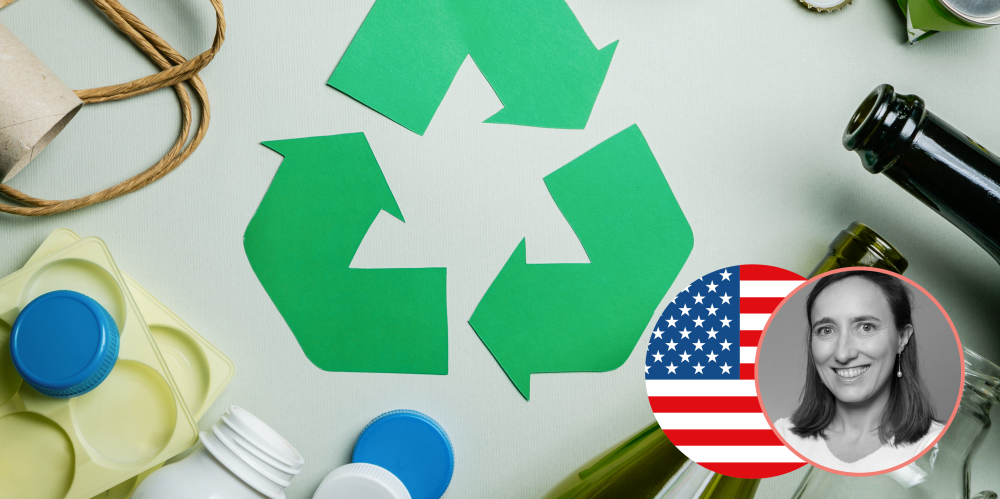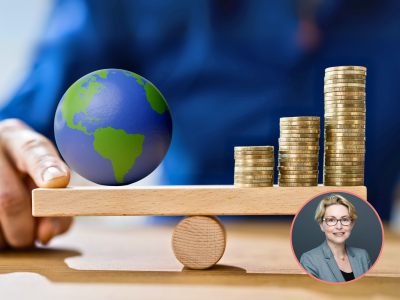Circular economy from a US perspective: towards transatlantic convergence? (1/2)

Photo Canva x Alice C.
Whereas the US initially missed the circular economy boat, the concept has currently the wind in its sails across the Atlantic.
The main conclusions of the Circularity Gap Report 2024, released on January 24, 2024, seem to epitomize what’s going on in the US about the circular economy: “Over the past five years, the volume of discussions, debates, and articles addressing this topic has almost tripled, reflecting a heightened awareness and interest in circularity. [...] Despite the circular economy reaching ‘megatrend’ status, lofty speeches and targets are not yet translating into on-the-ground actions and measurable impacts”[1].
Admittedly, the U.S. was originally a leader in developing key concepts that enable the circular economy. Some US pioneers, such as William McDonough or Ray Anderson, indeed paved the way for switching from a “take-make-waste” linear economy to circular “value loops”.
However, these visionary spirits don’t seem representative of the current mainstream American business, political and cultural mindset. In the last decades, circular economy concepts have been much more proactively implemented in the EU, in parallel with the early adoption of the precautionary principle which aims at preventing environmental damage at source. On the contrary, the US has not adopted precaution as an explicit basis, requiring firm scientific evidence of harm of a material or product before recognizing the need for its regulation.
Consequently, without caricaturing the degree of progress towards a circular economy between US and EU, some statistics speak for themselves:
- Landfilled waste fell 58% in the EU between 1995 and 2020 (with 23% of total municipal waste landfilled), while it increased 0.6% between 1990 and 2018 in the US (with 50% of total municipal waste landfilled) [2]
- Recycling rates differ, be it for glass containers (34 % in the US vs. 74% in the EU), aluminum containers (42 % in the US vs. 74% in the EU) or paper and cardboard packaging (68% in the US vs. 85% in the EU).
The American circular drivers: a less incentivizing context[3]
Compared to Europe, US-based companies must adapt to a very different framework regarding circularity.
- Economic drivers: The European consensus in favor of a circular economy is largely driven by employment and growth challenges, as well as energy efficiency and international competitiveness. With a lower unemployment rate, steady growth, cheaper domestic energy and export success, the US was less incentivized to be the first mover in the circular economy.
- Geographic drivers: Europe’s spatial constraints are more conflicting with the by-products of the linear economy, which are space-consuming. The larger availability of land in the US makes it less crucial to abandon the “take-make-waste” system.
- Social drivers: Despite millennials’ growing trend for the “sharing economy” and “right to repair”, and the increase in circular economy-focused litigation (lawsuits related to waste, recyclability, greenwashing, biodegradability…), American consumers’ behaviors remain dominated by rampant consumerism and a “convenience mindset“, and suffer from prevalent misinformation.
- Political drivers: While the European circular economy scheme is more based on a top-down strategy with a strong political anchorage, the later American shift is more bottom-up, driven by entrepreneurial innovations and local governments altogether.
- Business drivers: Among the business leaders in the circular economy, start-ups and SMEs seem over-represented, accounting for 56% of the American circular initiatives identified by Circular CoLab[4]. Compared to mission-driven small organizations, larger corporations seemed so far more locked in former corporate practices and processes that put the brakes on the shift from “do less bad” to “do good” business models and technological innovations. This discrepancy prevents radical rethinking in favor of circular business strategy and supply chains from scaling up.
[1] The Circularity Gap Report 2024. Circle Economy Foundation.
[2] The Evolution towards a Circular Economy. Goldman Sachs Equity Research. May 3, 2022.
[3] Which country is leading the circular economy shift? Interview of Joss Blériot by Joe Isles, June 28, 2021.
[4] The state of the circular economy in America – Trends, Opportunities, And Challenges. CircularColab. 2020.
Author : Alice C., People4Impact Expert
As a freelance writer and advisor, Alice Carré-Seemuller helps organizations committed to a more sober and resilient world to gain visibility and credibility. Her main areas of interest are circular & regenerative practices, soil health & sustainable food, climate change awareness & advocacy. After a 15-year experience as a senior civil servant in French local governments, she received a certification in Circular economics awarded by Harvard University.




